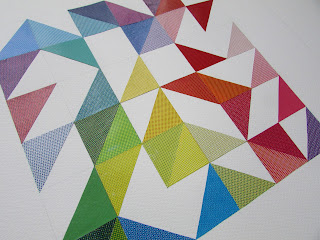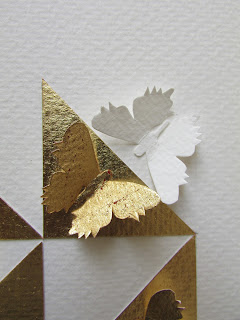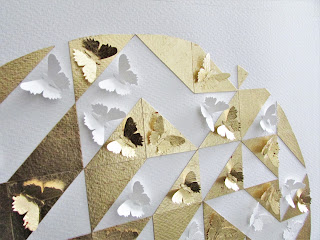.jpg)
Dazzle
"The thing is to dazzle." - Giacomo Casanova.
Dazzle (Gold leaf)
Dazzle
This new Dazzle series sees me investigating camouflage techniques adopted by butterflies and moths for survival. It is a further exploration of my ongoing interest in optical effects, and the way in which the eye reacts to patterns and rhythms, in this case the way in which these insects use their natural colours and patterning to resemble their surroundings. I had begun to explore the theme of optical effects in my art with my Ecstacy and Rapture series, (here, and here). These Dazzle artworks though go in a slightly different direction taking their cue from the various ways in which butterflies protect themselves through camouflage. Evolution and survival has seen the need for butterflies to avoid predators by concealing themselves and blending into their environments. This camouflage strategy is known as crypsis. Cryptic colouration means butterflies and moths can visually resemble their surroundings by matching the colour and texture thereby avoiding detection. They do this by folding up their wings to reveal either the upper or undersides to blend in with their background habitats to become almost invisible to predators. Most methods of crypsis also involves these insects keeping as still as possible to avoid their movement being detected by their predators. As well as crypsis, butterflies and moths also use a technique called mimesis which sees them using camouflage to look like or mimic something else such as a twig or leaf which would be of no interest to their predators. Examples of both these techniques can be seen below.
I delved further into camouflage techniques looking at how we as humans have adapted concealment techniques in our world most notably in war. I noticed that disruptive colouration or patterning is a method of camouflage which has been adapted by the military both in their uniforms, and as a method to break up the outlines of military vehicles. Purely from an art perspective I was particularly fascinated by the camouflage techniques developed during the First World War known as 'razzle dazzle' or 'dazzle' painting which involved covering boats and planes in a variety of bold, striking patterns to disrupt their silhouettes, making these modes of transport harder for the enemy guns to target, or get an accurate reading on their range, speed or destination.
I loved discovering the sheer variety of designs created by artists for the dazzle ships. They appeared to be mirroring the designs and artworks created in contemporary avant-garde art movements of the day such as Cubism, Futurism and Vorticism which emphasised dynamism through the impression of movement. One
of the artists who actually created dazzle designs for the navy and
then recorded the experience in print and paint at the end of the war was Edward
Wadsworth. The woodcut prints he created were highly influential on my early print work with
their stark imagery contrasting positive and negative areas of black and white, and the
patterns formed by the resulting strong geometric shapes. I also love the modern Pop Art dazzle design by Peter Blake currently being used on a ferry boat shuttling passengers across the river Mersey.
Collating all of the above information I began to develop my own dazzle designs. I have enjoyed working with grids previously with my Struktur series (here), but in these new Dazzle pieces I began devising square and circular grids from geometric shapes that were used to create decorative but disruptive patterns rather than harmonious ones. I played with triangular shapes cut from sheets of papers that I had applied gold leaf to by hand. Each Dazzle artwork features a random configuration of the triangular patterns and is therefore a unique artwork in itself. Once I was happy with the structure of the gold patterned base I began to add my signature hand-cut butterfly silhouettes. I chose to use the silhouette of the versatile little Hackberry Emperor butterfly which I've employed for its usefulness in creating pattern before. The colour and texture of these butterflies had of course to resemble the white and gold grounds so I have used the same papers, seemlessly blending white on white and gold on gold for the cryptic camouflage of the butterflies to be most effective. Interestingly under different light conditions throughout the day the placement of the various butterflies in these Dazzle artworks make them seem to disappear into their respective backgrounds or reappear, reflecting the light to betray their presence to would-be predators, making their camouflage qualities highly effective. Dazzle is available to commission in both square or circular formats. Contact me directly via Instagram DM or The Rowley Gallery (here) for availability or further details regarding the Dazzle series.
"Give 'em the old Razzle Dazzle!" - Fred Ebb/John Kander



























No comments:
Post a Comment